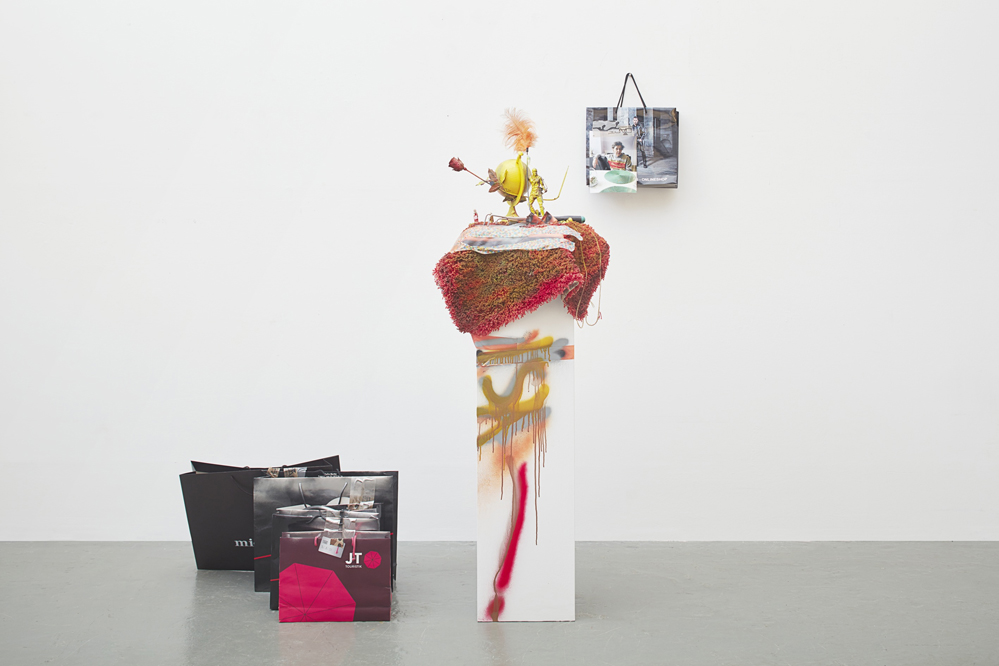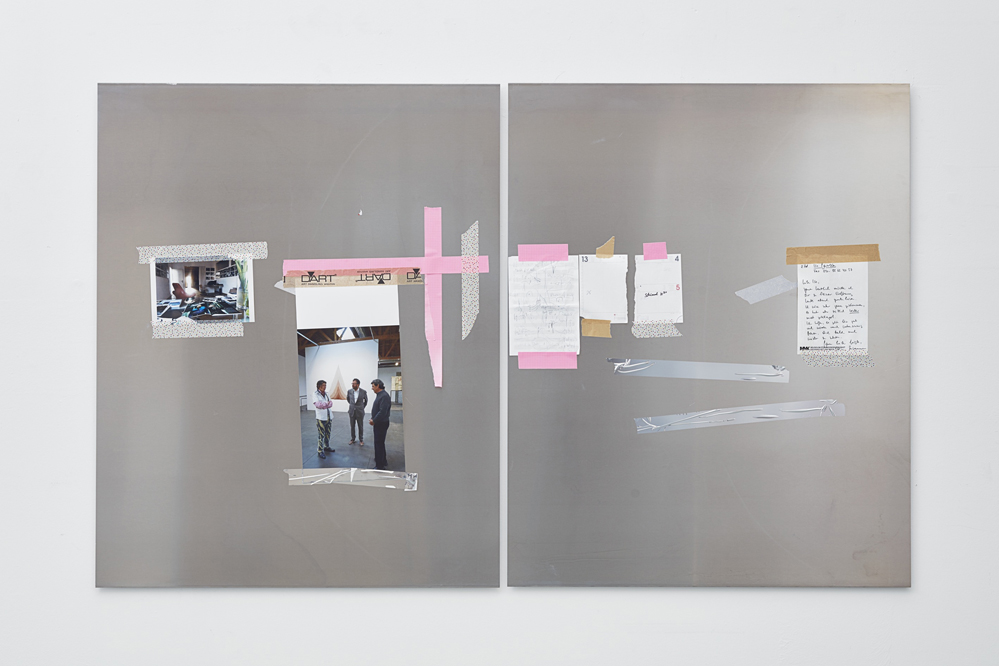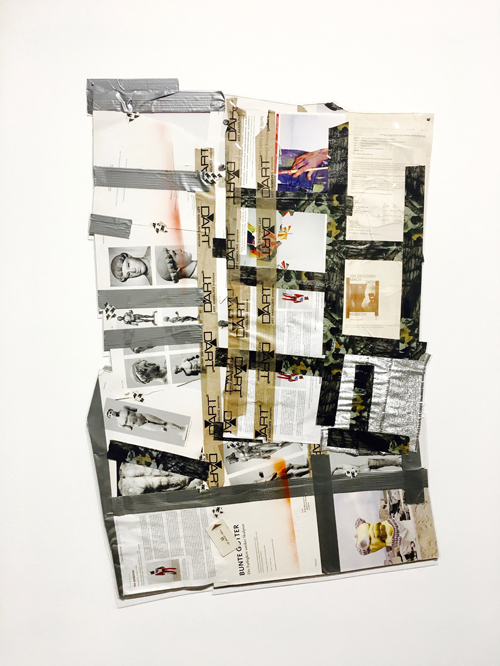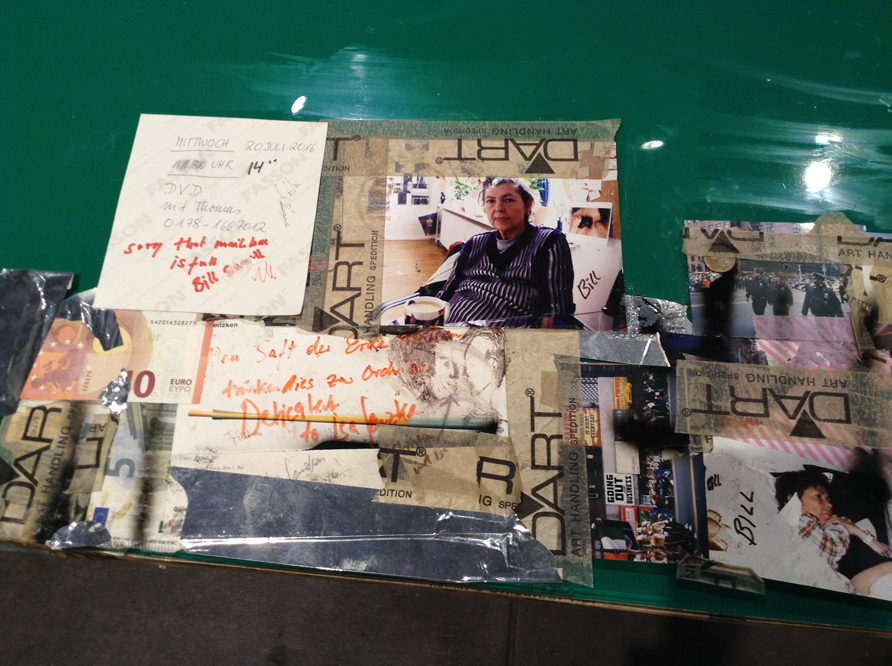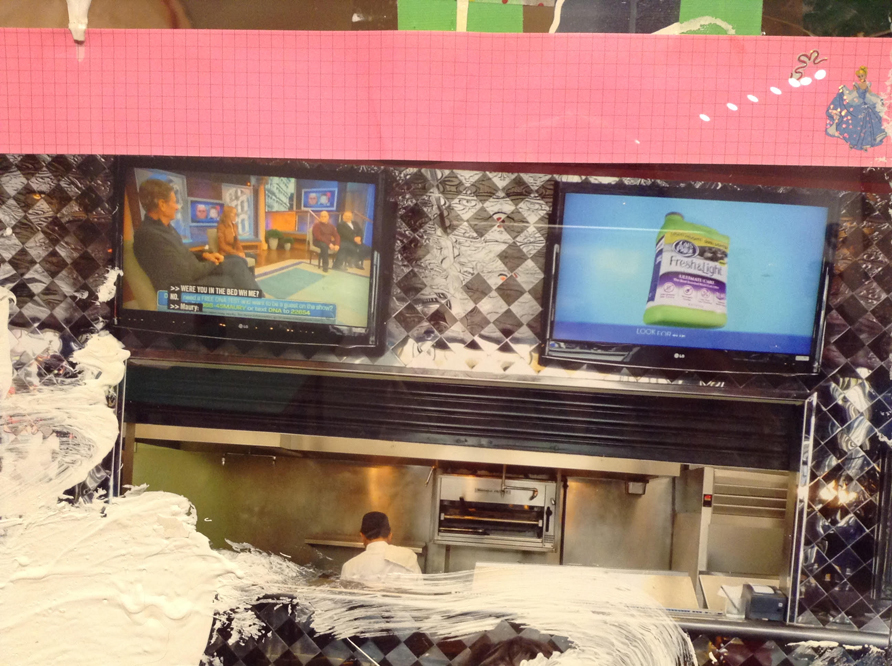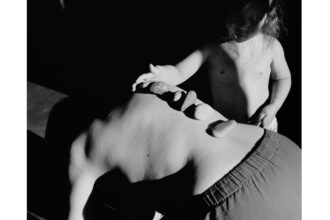“And why is this dedicated to Michael Jackson?” journalist Randy Kennedy asked Isa Genzken last February as both sat on a stage at the New School. The screen behind them displayed a mock-up of a public artwork Genzken never realized: a clothesline running between two buildings in a quaint public square, holding garments with Jackson’s picture on them. It was called Clothesline (dedicated to Michael Jackson) (2010). “I love Michael Jackson,” Genzken answered, her voice typically slow. Kennedy pushed no further.
Ten years ago, in 1996, Genzken made a messy-on-purpose book titled “I love New York,” full of scraps, souvenirs, and photographs constructed while she stayed in various Manhattan hotels. “My city,” she called New York in a rare interview, in 2014 — less “uptight and conventional” than Berlin, her home.
The artist titled her current show at Hauser Wirth & Schimmel, in downtown Los Angeles, I Love Michael Asher, after the L.A. artist revered as much or more for his teaching as for his art. She was in her twenties in 1977 when she met him. He was already deep into his “intervention” work, altering institutions by removing their doors or relocating their offices. Florian Berktold, a director at Hauser & Wirth Zurich who works closely with Genzken, said via email that, as far as he knows, “they did not stay in touch, but Genzken often referred to [Asher’s] practice.” She wanted to do this show in Los Angeles “in order to be able to connect” to him.
To pay tribute to him here, four years after his death, is on its surface a crowd-pleasing gesture. So many of his students and acquaintances live in L.A. We all love Michael Asher.
Upon initial encounter, Genzken’s show is delightful. It exudes that committedly renegade energy she’s become especially known for since she gave up on smooth, controlled – though not predictable – Minimalism back in the late 1980s. Collages spread out on the floor; an assemblage of plants, money, and power-drinks occupies a windowsill modeled after own kitchen sill. Irregularly-shaped, patched-together wall works make liberal use of her biography, currency, and tape supply. Show announcements or letters from curators appear alongside other debris, as do many photos of Genzken herself. Certain details are virtuosic. A strip of candy-striped tape on the seam between a male mannequin’s leg and thigh makes his fake body seem flimsier than it is. A screenshot from the Maury Show (“Were you bed with me? No,” a guest says according to the closed captions) appears framed inside an LG screen, above diamond-patterned wallpaper, next to an ad for Fresh & Light cat litter — and all these are minor elements in a single wall-hanging collage.
Zoom out, away from these details, however, and some needling questions about the show’s framing and content distract from the magic. How, exactly, is the exhibition an homage to Michael Asher, and what does it mean to honor an artist like him, revered by institutions he’s poked at, from within a commercial institution like Hauser Wirth & Schimmel? And what does it mean that this somewhat vague tribute is chock-full of references to Genzken’s own career?
Genzken has grappled with her relationship to the artworld’s insides before. In 1993, she wrote Sketches for a Feature Film, a collection of paragraph-long, flip and autobiographical vignettes. “Scene XV,” dated 1978, takes place in Düsseldorf. She attends a party at which live animals, like monkeys and elephants, run all over, and feels confused. Then she runs into her former professor, painter Gerhard Richter, who wants to give her champagne. “Yeah, great,” she says. In “Scene XVII,” dated 1988, she and Richter are married (and they would be, in real life, until 1994). She wants to know why he loves her; Richter says it’s too complex, and, also, he has a cold. She wants to know if they’re a special couple; Richter says he’d rather not be.
The scenes have a quizzical quality, like someone looking in on herself from the outside. A few years before Genzken composed them, she cajoled a friendly doctor – and drinking buddy – into X-Raying her head as she drank wine, laughed, and snacked. She also started collaging together clippings from Der Spiegel. In other words, the artist who had in 1983 named a slick wood totem after Richter, became increasingly scrappy and omnivorous. Her works reveal the “energy in disaster,” critic Hal Foster wrote of her 2014 MoMA retrospective, framing her project as a send-up of contemporary capitalism.
At Hauser Wirth & Schimmel, Genzken treats currency as malleable and disposable just like the paper shopping bags, plastic toys, and Styrofoam coolers she employs in her sculptures. Coins, a dollar bill, a stick, foil, and pink tape have been attached to a canvas that hangs above a tangle of altered umbrellas. At best, these salvaged objects are building-blocks for plastic, multi-colored anti-monuments that don’t take themselves or their art status seriously at all – though their iconoclasm would be more convincing if not on view in one of the world’s most successful blue-chip galleries.
Gallery partner Paul Schimmel explained over the phone that, according to Genzken, Michael Asher taught her about architecture – its “edges” in particular. Asher, whose CalArts critique classes sometimes went all night, liked to expose infrastructure and increase access. One of his final projects, for the 2010 Whitney Biennial, was to keep the Whitney opened 24 hours a day (the museum could only afford this three days a week). In 2008, at the Santa Monica Museum of Art, Asher rebuilt every temporary wall constructed in the gallery since 1998, turning its history into a maze of metal and wood studs. His mother, Betty Asher, had been a gallerist and collector of note and, according to his former student, Michael Baers, Asher gave away his mother’s art collection piece by piece after her death in 1994. He, like Genzken, had insider connections and knew well the world of commerce that he sidestepped.
Genzken had already titled her exhibition “I Love Michael Asher” before she made most of the work in it, including the tape-covered Asher-esque wall that bisects the second gallery. The press release claims that this is Genzken’s first solo show in Los Angeles, suggesting she’s debuting in this increasingly international art city – more European and New York galleries have opened in L.A. since 2014 than ever before – with a tribute to a kindred spirit. This isn’t necessarily true. She had an exhibition at China Art Objects in Chinatown in 2004, though it was concurrent with a solo show of artist Andy Alexander’s work and so her CV on Hauser & Wirth’s website calls it a “two-person show.” China Art Objects’s director confirmed via email that they considered Genzken’s show a solo one, a discrepancy worth pointing out because narratives of scarcity are so central to artworld boosterism. So are narratives of association – like friendships with famous artists, or big museum shows.
Perhaps thinking of Michael Asher made Genzken reflect back on the institutions her works have inhabited, because we are reminded at every turn that she has shown a lot in recent years. She spray-painted on aluminum the words “Science Fiction” after her 2001 collaboration with Wolfgang Tillmans, and attached to an adjacent aluminum diptych a photograph of herself surveying the gallery space with Schimmel and Iwan Wirth. A collage held together with camo-tape includes a letter from the Stedelijk Museum in Amsterdam about a reproduction of a Nefertiti bust needed for a Genzken exhibition poster. This strain of self-referentiality doesn’t serve to question her relationships to art institutions as much as confirm that she has them.
But it coexists with those impulses of Genzken’s that prompt her to attach her own likeness to a shopping bag and hang it on a pristine white wall, or clip a photograph of a trash bag to a haphazard, ceiling-suspended contraption of cardboard and plastic that makes indirection look desirable. If this show’s insider-ness tamps the defiance of convention and professionalism otherwise present in the art, it also reaffirms the need for such defiance. Naval-gazing shows tend to be obedient: referencing the artworld and an artist’s identity in ways that conform to an institutional script of what matters and thus indulges those already in the know. Genzken, at her best, is far more generous than this. She grabs willy-nilly from a consumer culture familiar to most Westerners as well as from her own private life, reassembling it all in a way that revels in our complicity in a market-driven mess. When she plays with and pokes at a system without pandering to it, she invites us to imagine that system’s power giving way to intuitive weirdness. In her show at Hauser Wirth & Schimmel, it’s harder than it should be to imagine such power shifts.


